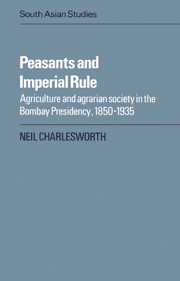Book contents
- Frontmatter
- Contents
- List of maps and tables
- Preface
- Note on technical terms and references
- Maps
- 1 Introduction: the peasant in India and Bombay Presidency
- 2 The village in 1850: land tenure, social structure and revenue policy
- 3 The village in 1850: land and agriculture
- 4 Indebtedness and the Deccan Riots of 1875
- 5 Continuity and change in the rural economy, 1850–1900
- 6 The Bombay peasantry, 1850–1900: social stability or social stratification?
- 7 The agricultural economy, 1900–1935: the critical watershed?
- 8 The impact of government policy, 1880–1935
- 9 The peasant and politics in the early twentieth century
- 10 Conclusions: the problem of differential commercialisation
- Glossary
- Bibliography
- Index
9 - The peasant and politics in the early twentieth century
Published online by Cambridge University Press: 10 December 2009
- Frontmatter
- Contents
- List of maps and tables
- Preface
- Note on technical terms and references
- Maps
- 1 Introduction: the peasant in India and Bombay Presidency
- 2 The village in 1850: land tenure, social structure and revenue policy
- 3 The village in 1850: land and agriculture
- 4 Indebtedness and the Deccan Riots of 1875
- 5 Continuity and change in the rural economy, 1850–1900
- 6 The Bombay peasantry, 1850–1900: social stability or social stratification?
- 7 The agricultural economy, 1900–1935: the critical watershed?
- 8 The impact of government policy, 1880–1935
- 9 The peasant and politics in the early twentieth century
- 10 Conclusions: the problem of differential commercialisation
- Glossary
- Bibliography
- Index
Summary
Economic and social change has featured prominently in our analysis of western India's agrarian history: the differential spread of commercialisation in peasant agriculture, consequent geographical and social stratification and the intensification of demand for and pressure on land. Would this, in turn, produce a political response from the peasantry? The question is important because the history of Indian politics in Bombay Presidency, as elsewhere, would seem to demand a more intricate understanding of the rural situation from at least the First World War era. With Gandhi's emergence, action and protest apparently became much more broadly based. Some of the most persuasive accounts of politics, it is true, see the dynamic of local action as mainly faction-based competition for office and pickings, resulting in wide-ranging cross-class, cross-caste alliances. In theory, this interpretation firmly denies the existence of mass objectives or grievances as an impetus behind politics, but it is striking how, in practice, even here, rural economic change is frequently introduced as a decisive determinant of political developments. Further, it could not be denied that agrarian protest campaigns, whatever their derivation, proved an important propagandist and practical weapon against the British Raj in the twentieth century: the Bardoli campaign of 1928, as we have noted, ended revision land revenue settlements in the Bombay Presidency. So the character of peasant political behaviour in the western India of 1900–35 demands analysis and may, in turn, throw further light on economic and social processes.
- Type
- Chapter
- Information
- Peasants and Imperial RuleAgriculture and Agrarian Society in the Bombay Presidency 1850–1935, pp. 268 - 291Publisher: Cambridge University PressPrint publication year: 1985



